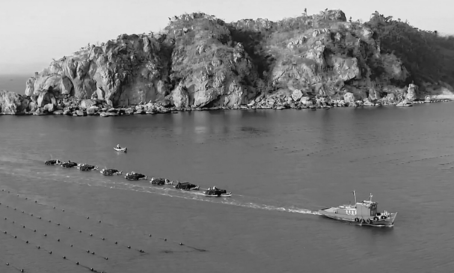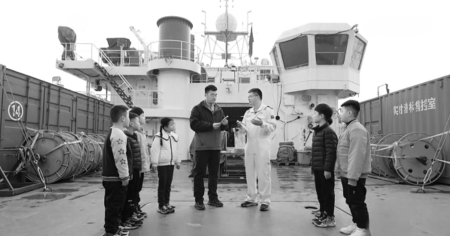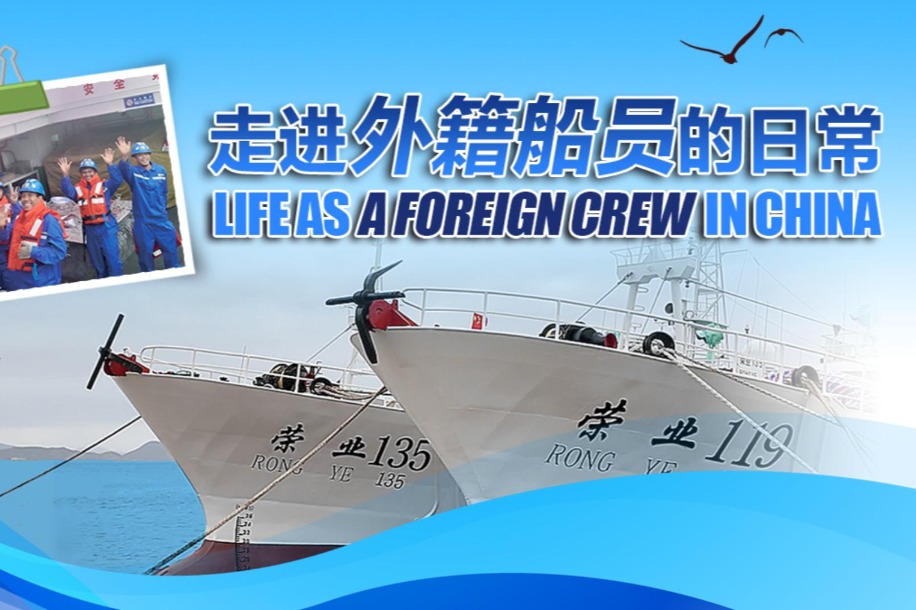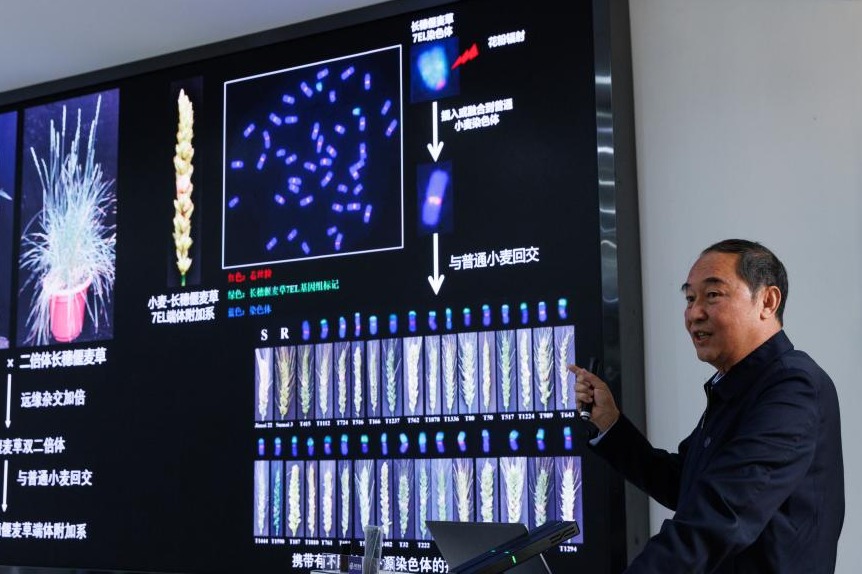Waves of knowledge
Interactive TV program seeks to popularize marine sciences and understanding of the ocean among the general public, Li Yingxue reports.

Liang Xixiang, captain of the research vessel Kexue, welcomes a group of children aboard the ship as part of an educational tour. They explore various areas, starting from the fore-deck and moving to the control room, aft deck and central control laboratory.
During the tour, Liang introduces the living facilities, the dynamic positioning system, and the remarkable "submarine buoy" that's capable of collecting data about ocean currents and forecasting abnormalities in weather.
Liang further explains that the control room's screen displays real-time data collected at depths ranging from zero to 400 meters in the western Pacific Ocean. By comparing this data with previously collected information and conducting comparisons with nearby targets, scientists can uncover patterns and variations in ocean currents and identify any abnormalities.
"This analysis plays a crucial role in studying future climate changes and predicting potential climate-related disasters," he says.
Liang's tour is a significant component of the Ocean Open Class, an interactive TV program focused on marine and maritime culture. This program invites renowned scientists, experts from research institutions, and volunteers from the People's Liberation Army Navy and marine environmental organizations to deliver engaging lectures.
On June 8, in celebration of World Oceans Day, which was themed "The Planet Ocean's Changing Tide", the Ocean Open Class debuted on Fujian South East TV and Fujian Straits TV.
The show provides comprehensive and multi-perspective explanations on various ocean-related topics, including marine territorial issues, marine economy, marine technology, marine culture and marine ecology.
It received such widespread attention that it registered the third-highest viewership among satellite TV channels, according to the ratings from CSM Media Research.
Following the broadcast, the program garnered over 170 million online views and was livestreamed on 30 online platforms, with a total viewership exceeding 50 million. Furthermore, the program's short videos garnered over 60 million views.
Diving into the subject
In the program, Xu Kuidong, a researcher at the Institute of Oceanology, Chinese Academy of Sciences, takes the audience on a journey through the marvelous history of marine life using the Hai Cuo Tu, China's earliest comprehensive encyclopedia of marine organisms.
"Even in this era of rapid technological advancement, only 5 percent of the ocean floor has been explored. Research suggests that there could be 1 million species in the ocean, yet we have only uncovered about a quarter of them," explains Xu.
The allure of the extraordinary marine creatures is simply irresistible. As a dedicated scientist, Xu is committed to venturing deeper into the ocean to explore its vibrant and diverse marine life, and he also looks forward to sharing more captivating tales of the wondrous ocean with everyone.
In another installment, Liu Feng, the overall commander of the Jiaolong manned submersible, shares the story behind the design of the ship.
The Jiaolong manned submersible, the research, development, and testing process of which he participated in, is China's first independently designed and integrated manned deep-sea submersible. It is world-leading and has broken records for the depths it can reach compared to similar operational manned submersibles.
With global media focused on such matters following recent tragic events, according to Liu, ensuring the safety of personnel was the foremost consideration during the design of the Jiaolong submersible. Due to the immense pressure the submersible would be subjected to, a spherical three-dimensional structure, known for its stability, was chosen.
"The manned sphere, in particular, has a thick wall that couldn't be formed through a single stamping process. Instead, we welded together 12 watermelon-shaped segments to create two hemispheres, which were then joined to form a complete sphere," he says.
"We also incorporated three observation windows and an access hatch for personnel. With the presence of multiple openings in the sphere, the precision and requirements for its production were incredibly high," Liu explains.
Liu believes that the greatest accomplishment of the Jiaolong's development is not the submersible itself, but rather the growth of scientists throughout the process, which has provided a solid foundation for further deep-sea exploration.
One highlight of the show is that it utilizes augmented reality and extended reality to provide interactive on-site experiences, with the aim of popularizing science among the general public.
Over the course of the program, the stage design undergoes multiple changes, encompassing elements such as submarines, aquariums, and artistic representations of ocean waves.
Leveraging XR technology, the grandeur of the ocean world is seamlessly integrated into the stage, resulting in an immersive audiovisual experience for the audience.
When Tang Limei, the first female scientist in China to dive aboard the Jiaolong manned submersible, shared her story, the screen behind her transformed into a deep-sea sightseeing elevator.
"During the time spent aboard the Jiaolong, I witnessed the most unforgettable and mesmerizing deep-sea scenery. Planktonic organisms swarmed like snowflakes in the vast expanse, while bioluminescent creatures illuminated the dim abyss with their radiant glow," Tang recalls.
From the perspective of the elevator, the audience is taken on a journey, plunging deep toward the seabed, getting to know the underwater world.
"As we descended to a depth of 1,000 meters, we encountered a group of enchanting creatures. To adapt to the darkness they inhabit, they have evolved the ability to emit their own light," Tang says.
"Among them, the bioluminescent properties of the glass octopus stood out. Its transparent body allowed us to see its internal organs clearly, making it the brightest star of the deep sea."
Tang was thrilled when she saw the AR scenes during the recording. "I didn't expect that the scenes presented in the design plan would come to life like that," she says.
A sea of information
The program is jointly produced by Fujian Media Group and Xinhua News Agency's web portal, Xinhuanet.
It is a collaborative effort involving institutions such as the Ocean University of China, the Institute of Oceanology, the Chinese Academy of Sciences, Xiamen University, and China National Offshore Oil Corporation.
Li Canyu, general director of the show, says that he thinks Fujian Media Group has a production advantage due to its proximity to the ocean, its extensive experience in creating marine-themed programs, and its valuable collaborations with universities specializing in marine studies.
"The program goes beyond the boundaries of Fujian's coastline and extends its scope to the oceans of China and even the world," he says.
According to Li, the show started its preparation in June last year and the recording of the program was successfully completed in Beijing in March.
Li says the show aims to promote the spirit of the ocean, raise awareness of marine education and lead the audience to gain a deeper understanding of the close relationship between marine science and their everyday lives.
The production team selected over 10 themes from more than 100 topics for the program. They highlighted significant recent news events related to the ocean and presented a wealth of "cool facts" about the ocean, captivating and entertaining the audience with fascinating marine stories.
To ensure the professionalism and richness of the content, the production team made special visits to various locations such as Qingdao, Shandong province, Shanghai, Beijing, and Xiamen, Fujian province, to conduct research at marine research institutions and meet with experts and scholars in the field of marine studies.
Li says the selection of lecturers involved choosing representatives who cover various aspects of the ocean and prominent scientists who represent the field of marine science.
"The marine scientists have a strong desire to popularize science, and, in their lectures, several of them expressed their desire to see more young people engage in future marine endeavors. They see it as their responsibility to inspire and involve the younger generation in the field of marine science," Li says.
Li notes that, during recording, the live studio audience was filled with excitement. They clearly appreciated the opportunity to learn from the top scientists who were sharing their expertise firsthand, and the interactive nature of the program was also intriguing to them, he says.
"Whether it was the demonstration of artificial wave-making, experiments simulating seawater pressure, or the live tasting of salmon, the audience found these experiences both novel and enlightening," Li says.
During the production process, Li became acutely aware of the immense importance of the ocean. "Even after receiving a comprehensive higher education, many people still have a limited understanding of the ocean. That's why we have designed this program to serve as a general marine education course for the entire nation," he says.
He emphasizes that popularizing knowledge of the ocean is a gradual process that requires a long-term approach to ensure a comprehensive understanding among the general public.
Li believes that with the advancement of technology, there will be an increasing number of interactive educational programs. "We hope to launch a new episode of the Ocean Open Class every year on June 8, offering a continuous supply of rich marine knowledge to our audience," he says.



Today's Top News
- Effective use of investment emphasized
- China's shuttle diplomacy strives to reach ceasefire
- Nanjing Museum's handling of donated art, relics being probed
- Key role of central SOEs emphasized
- New travel program hailed as 'milestone'
- Animated films top draw at box office






























